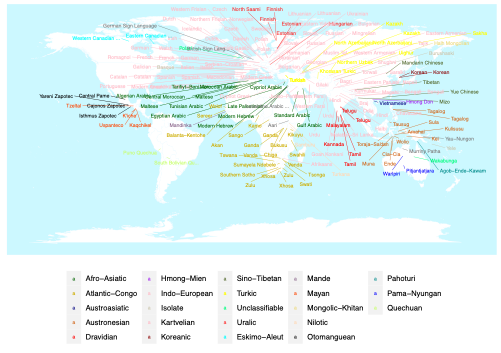ACCLAIM: Assessing Computational models of the Cross-Linguistic Acquisition of Inflectional Morphology
Language is one of the hallmarks of the human species, with inflectional morphology (e.g., play / play[s] / play[ed]) long recognized as a well-specified testing ground for comparing rival theoretical accounts. The aim of the ACCLAIM project is to move the field towards a mechanistic quantitative account of human language acquisition by comparing computational models on their ability to explain child-acquisition and adult-representation of inflectional morphology across as many typologically-diverse languages as possible, combining experimental and computational methods.
To do so, we first need to understand the acquisition process, in terms of the patterns of children's errors and correct production across the world's diverse languages. Second, we need to understand the nature of adults' morphological representations, which allow them to inflect obscure and even novel items. With these data in hand, we will be in a position to discover which theoretical accounts of morphological acquisition, when instantiated as computational models, best explain these phenomena of child-acquisition and adult-representation across a typologically-diverse, representative sample of the world's languages

ACCLAIM: Progress to date
So far, we have recruited in-principle collaborators from researchers studying 115 languages across 26 families plus isolates. We have submitted an application for funding that would provide for (a) 10,000 Euros expenses for each of 50 language teams, (b) two postdoctoral researchers to manage and coordinate the international child and adult studies and (c) a postdoctoral computational modeller to conduct the modeling work. If this application is not succesful, we will explore alternative funding sources and alternative models for the project (such as international language teams contributing on a no-cost basis). To find out more, or to volunteer for the project in any capacity, please contact the Principal Investigator, Prof. Ben Ambridge at the University of Manchester
Relevant previous publications
Engelmann, F., Granlund, S., Kolak, J., Zreder, M., Ambridge, B., Pine, J.M., Theakston, A.L., & Lieven, E.V.M. (2019). How the input shapes the acquisition of verb morphology: Elicited production and computational modelling in two highly inflected languages. Cognitive Psychology, 110 30-69 [open access]
Granlund, S., Kolak, J., Vihman, V., Engelmann, F., Lieven, E.V.M., Pine, J.M., Theakston, A.L. & Ambridge, B. (2019). Language-general and language-specific phenomena in the acquisition of inflectional noun morphology: A cross-linguistic elicited production study of Polish, Finnish and Estonian. Journal of Memory and Language, 107 169-194 [open access]
Pimental, T., Ryskina, M., Mielke, Wu, S., Chodroff, E., Leonard, B...Ambridge, B. & Vylomova, E. (2021). SIGMORPHON 2021 Shared task on morphological reinflection: Generalization across languages. In Proceedings of the 18th SIGMORPHON workshop on computational research in phonetics, phonology, and morphology. Association for Computational Linguistics (pp. 229-259). DOI: 10.18653/v1/2021.sigmorphon-1.25 [open access]
Saviciute, E., Ambridge, B., & Pine, J.M. (2018). The roles of word-form frequency and phonological neighbourhood density in the acquisition of Lithuanian noun morphology. Journal of Child Language, 45(3), 641-672 [open access]
Ambridge, B., Doherty, L., Maitreyee, R., Tatsumi, T., Zicherman, S., Mateo-Pedro, P., Kawakami, A., Bidgood, A., Pye, C., Narasimhan, B., Arnon, I., Bekman, D., Efrati, A., Pixabaj, S.F.C, Peliz, M.M., & Mendoza, M.J, Samanta, S., Campbell, S., McCauley, S., Berman, R., Sharma, D.M., Nair, R.B. & Fukumura, K (2021). Testing a computational model of causative overgeneralizations: Child judgment and production data from English, Hebrew, Hindi, Japanese and Kiche, Open Research Europe, 1(1) https://doi.org/10.12688/openreseurope.13008.1
Ambridge, B. (2022). Why Algebraic systems aren't sufficient for syntax: Experimental evidence from passives in English, Mandarin, Indonesian, Balinese and Hebrew. In S. Lappin & J-P. Bernardy (Eds)Algebraic Structures in Natural Language . [pdf]
Darmasetiyawan, I.M.S. & Ambridge, B. (2022). Syntactic representations contain semantic information: Evidence from Balinese passives. Collabra: Psychology, 8(1), 33133. https://doi.org/10.1525/collabra.33133 [open access]
Aryawibawa, I.N., Qomariana, Y., Artawa, K., & Ambridge, B. (2021). Direct versus indirect causation as a semantic linguistic universal: Using a computational model of English, Hebrew, Hindi, Japanese and Kiche Mayan to predict grammaticality judgments in Balinese. Cognitive Science, 45(4),e12974 https://doi.org/10.1111/cogs.12974 [open access]
Liu, L. & Ambridge, B. (2021). Balancing information-structure and semantic constraints on construction choice: building a computational model of passive and passive-like constructions in Mandarin Chinese. Cognitive Linguistics, 32(3), 349-388.https://doi.org/10.1515/cog-2019-0100 [open access]
Ambridge, B., Maitreyee, R., Tatsumi, T., Doherty, L., Zicherman, S., Mateo-Pedro, P., Bannard, C., Samanta, S., McCauley, S., Arnon, I., Bekman, D., Efrati, A., Berman, R. Narasimhan, B., Sharma, D.M., Nair, R.B., Fukumura, K., Campbell, S., Pye, C., Pixabaj, S.F.C, Peliz, M.M., & Mendoza, M.J., (2020). The Crosslinguistic acquisition of causative sentence structure: Computational modeling and grammaticality judgments from adult and child speakers of English, Japanese, Hindi, Hebrew and Kiche, Cognition, 202,104301, https://doi.org/10.1016/j.cognition.2020.104310 [open access] [stimuli, data, code]
Aryawibawa, I.N & Ambridge, B. (2019). Is syntax semantically constrained? Evidence from a grammaticality judgment study of Indonesian. Cognitive Science, 42(8), 3135-3148 [OSF]
Tatsumi, T., Ambridge, B., & Pine, J. M. (2018). Testing an input-based account of children's errors with inflectional morphology: An elicited production study of Japanese. Journal of Child Language, 45(5), 1144-1173. [Open Access]
Tatsumi, T., Ambridge, B., & Pine, J. M. (2018). Disentangling Effects of input frequency and morphophonological complexity on children's acquisition of verb inflection: An elicited production study of Japanese. Cognitive Science, 42(S2), 555-577. [open access] [blog post]
Aguado-Orea, J., Otero, N. & Ambridge, B. (2016). Statistics and Semantics in the acquisition of Spanish word order: Testing two accounts of the retreat from locative overgeneralization errors. Linguistics Vanguard, 2(1), 1-22[open acess]